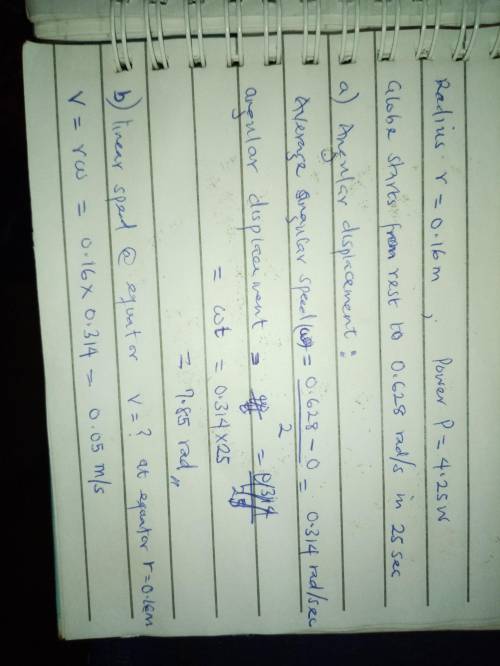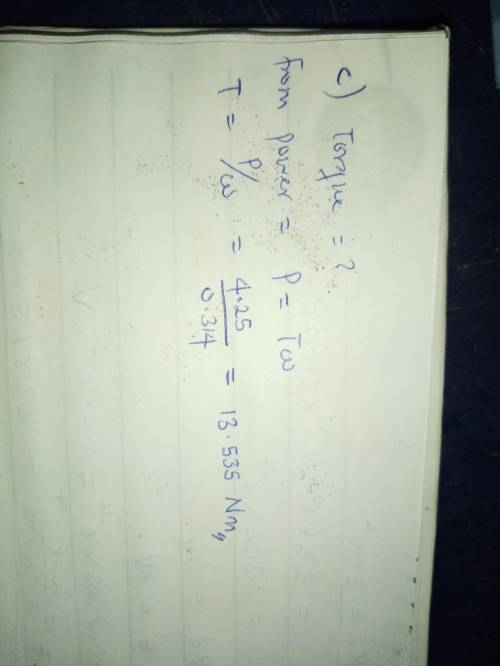
Physics, 22.04.2020 18:40 bigboifylod13
Guadalupe has a motorized globe on her desk that has a 0.16 m radius. She turns on the 4.25-watt motor and the globe begins to spin. The globe starts from rest and has a final rotational speed of 0.628 rad/s (1 revolution per 10 seconds). The globe reaches this speed in 25 seconds.
A. What is the angular displacement during the 25-second time interval in radians?
B. What is the linear speed of a point on the globe’s equator?
C. What is the average torque provided by the motor during the 25-second time interval?

Answers: 2


Another question on Physics

Physics, 21.06.2019 22:30
Follow these directions and answer the questions. 1. shine a pencil-thin beam of light on a mirror perpendicular to its surface. (if you don't have a laser light as suggested in the video, you can make a narrow beam from a flashlight by making a cone from black construction paper and taping it over the face of the flashlight.) how does the light reflect? how does the relationship of incident to reflected ray relate to the reflection of water waves moving perpendicular to a barrier? 2. shine a pencil-thin beam of light on a mirror standing on a sheet of paper on the table (or floor) so that you can mark the incident ray and reflected ray. (you can support the mirror from the back by taping it to a wooden block.) 3. mark a line on the paper representing the reflective surface. (the reflective surface of a mirror is usually the back edge.) 4. draw a dashed line perpendicular to the mirror surface at a point where the incident and reflected ray meet. this perpendicular is called a normal to the surface. 5. measure the angles between the rays and the normal. the angle of incidence is the angle formed by the incident ray and the normal to the surface. the angle formed by the reflected ray and normal is called the angle of reflection (r). what is the angle of incidence? what is the angle of reflection? 6. repeat for several different angles. (see report sheet for details.) what appears to be the relationship between the angle of incidence and angle of reflection? in science 1204, what was the relationship for these two angles made by the reflection of waves in a ripple tank? 7. roll a ball bearing so that it hits a fixed, hard surface (a metal plate) at several angles (including head-on). observe the way in which the ball bearing reflects. what generalization can you make about how a ball bearing reflects from a wall? have you proved that light can only behave like a wave?
Answers: 1

Physics, 22.06.2019 15:30
What is a view of science and psychology that says the value of knowledge depends on its usefulness? a. pragmatism b. psychotherapy c. physiology
Answers: 2

Physics, 23.06.2019 02:50
You are still fascinated by the process of inkjet printing, as described in the opening storyline for this chapter. you convince your father to take you to his manufacturing facility to see the machines that print expiration dates on eggs. you strike up a conversation with the technician operating the machine. he tells you that the ink drops are created using a piezoelectric crystal, acoustic waves, and the plateau-rayleigh instability, which creates uniform drops of mass m = 1.25 ✕ 10−8 g. while you don't understand the fancy words, you do recognize mass! the technician also tells you that the drops are charged to a controllable value of q and then projected vertically downward between parallel deflecting plates at a constant terminal speed of 20.0 m/s. the plates are ℓ = 2.15 cm long and have a uniform electric field of magnitude e = 6.40 ✕ 104 n/c between them. noting your interest in the process, the technician asks you, "if the position on the egg at which the drop is to be deposited requires that its deflection at the bottom end of the plates be 0.17 mm, what is the required charge on the drop (in c)? " you quickly get to work to find the answer. (neglect the force of gravity.)
Answers: 1

Physics, 23.06.2019 05:00
How long will it take a car traveling of a constant speed of 45m/s to cover the distance of a 2.5km?
Answers: 1
You know the right answer?
Guadalupe has a motorized globe on her desk that has a 0.16 m radius. She turns on the 4.25-watt mot...
Questions


Mathematics, 05.04.2021 17:50

Business, 05.04.2021 17:50

Biology, 05.04.2021 17:50

Social Studies, 05.04.2021 17:50

Biology, 05.04.2021 17:50


Mathematics, 05.04.2021 17:50

English, 05.04.2021 17:50
















